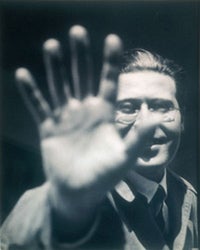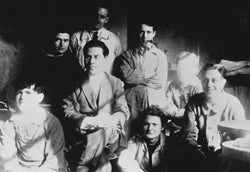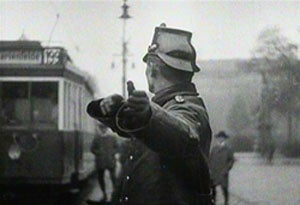I first came across the Hungarian painter-photographer-filmmaker-theorist, László Moholy-Nagy, in 1979 when I co-reconstructed the Weimar art exhibition, “Film und Foto” (1929). “FiFo” brought together avant-garde film and photography from all over Europe and the United States to Stuttgart, Germany, a city in the vanguard of modernist architectural and city planning. That exhibit had originally been curated by László Moholy-Nagy (photography) and Hans Richter (film), both of whom also contributed works, and has ever since been cited as a groundbreaking event in texts on European Modernism in general, and the Bauhaus school in particular.
 The exhibition catalog, which was co-edited by myself and my German colleague and long-time friend, Ute Eskildsen (really the motor behind the whole project), became my first book. A few years later, I published a piece on Moholy-Nagy’s films, which for the first time established a reliable filmography of his work. This job was only made possible by the fact that Moholy’s film estate had gone to George Eastman House, where I was Senior Curator, so I could actually preserve and see the films. For a while, I had a lively correspondence with Dr. Hattula Moholy-Nagy, Laszlo’s daughter. And, finally, Moholy-Nagy was never far from my mind when I was writing my Saul Bass book, given that Bass not only studied under Moholy-Nagy’s Bauhaus student, György Kepes, but also seemingly imbibed Moholy-Nagy’s book, The New Vision: From Material to Architecture, reutilizing many of the visual ideas in the book for his subsequent signature designs.
The exhibition catalog, which was co-edited by myself and my German colleague and long-time friend, Ute Eskildsen (really the motor behind the whole project), became my first book. A few years later, I published a piece on Moholy-Nagy’s films, which for the first time established a reliable filmography of his work. This job was only made possible by the fact that Moholy’s film estate had gone to George Eastman House, where I was Senior Curator, so I could actually preserve and see the films. For a while, I had a lively correspondence with Dr. Hattula Moholy-Nagy, Laszlo’s daughter. And, finally, Moholy-Nagy was never far from my mind when I was writing my Saul Bass book, given that Bass not only studied under Moholy-Nagy’s Bauhaus student, György Kepes, but also seemingly imbibed Moholy-Nagy’s book, The New Vision: From Material to Architecture, reutilizing many of the visual ideas in the book for his subsequent signature designs.
So now, I’ve just finished reading a special issue of the German academic journal, Maske und Kothurn, edited by Thomas Tode, and titled Bauhaus & Film (Vol. 57, No. 1-2, 2011). László Moholy-Nagy was the central film figure in the Bauhaus, theorizing about film, and writing fantastical scenario’s that themselves were visual works of art, without actually producing any film until after his departure from the Bauhaus. Interestingly, even though the Bauhaus, when it was founded in 1919, was dedicated to training artists for all the arts, the institution was never actually able to set up a film program. Furthermore, virtually all of the Bauhaus film projects never made it past the planning stages, or were produced after the artist left the Bauhaus, as in the case of Moholy-Nagy.
“The Bauhaus nevertheless had a huge influence on the subsequent history of avant-garde film...”
The Bauhaus nevertheless had a huge influence on the subsequent history of avant-garde film, thanks to the theoretical texts of Moholy-Nagy, Theo van Doesburg, Hans Richter, Kepes, and others; to the teaching done by Richter (New York), Moholy-Nagy (Chicago), Kepes (Harvard), etc.; and to the eventual realization of Bauhaus film scripts in the 1960s and 1970s, including works of Werner Graeff, Ludwig Hirschfeld-Mack, and Kurt Schwerdtfeger. These late additions found enthusiastic audiences from among the contemporary 60s avant-garde, leading to a revival in interest in 1920s modernist art, yet, surprisingly, in the thirty-plus years since then, no coherent study of the Bauhaus and film has appeared. The present volume attempts to fill that void, offering a variety of essays by senior writers, like Birgit Hein (whose first book helped me organize “Fifo”), mid-career historians, like Thomas Tode, and junior scholars, like Marton Orosz.
 Thomas Tode’s editorial introduction to the volume, and essay, “School of Vision. About the interdisciplinary aspects of film at the Bauhaus,” lays the groundwork for the volume that follows, arguing that historians should focus on the actual successes, the realized film projects and the theory, rather than on the failure to achieve a mass audience (as Bauhaus had done with its consumer product design aesthetic). Three distinct genres of films emerged from the Bauhaus canon: abstract or absolute experimental films, socially-critical documentary reportages, and polemical films for and about the New Architecture, as it was called. Moholy-Nagy of course produced work in all three genres, including his elegiac Gypsies (1932), banned in Nazi Germany a few short years before a large portion of Europe’s Sinti and Roma population would disappear into the German death camps.
Thomas Tode’s editorial introduction to the volume, and essay, “School of Vision. About the interdisciplinary aspects of film at the Bauhaus,” lays the groundwork for the volume that follows, arguing that historians should focus on the actual successes, the realized film projects and the theory, rather than on the failure to achieve a mass audience (as Bauhaus had done with its consumer product design aesthetic). Three distinct genres of films emerged from the Bauhaus canon: abstract or absolute experimental films, socially-critical documentary reportages, and polemical films for and about the New Architecture, as it was called. Moholy-Nagy of course produced work in all three genres, including his elegiac Gypsies (1932), banned in Nazi Germany a few short years before a large portion of Europe’s Sinti and Roma population would disappear into the German death camps.
Both Tode, and a subsequent essay by Norbert M. Schmitz, focus on Moholy-Nagy’s specific theoretical and practical interest in light and the construction or deconstruction of space and time in film, by reading Moholy-Nagy’s book, Painting, Photography, Film (1925). Schmitz, however, argues for the failure of film at the Bauhaus, given the truly mass reception of Bauhaus design and painting, directly contradicting Tode’s piece. But both agree that Moholy-Nagy must be seen with Walter Ruttmann and Dziga Vertov, as key figures in the creation of avant-garde documentaries that expanded audience vision by challenging all known conventions of Hollywood continuity editing.
 Andres Haus picks up that thread, speculating that Moholy-Nagy’s eight page film manuscript, Dynamics of the City, directly influenced the explosion of so-called city films in the 1920s, including Ruttmann’s Berlin: Symphony of a Great City (1927), Vertov’s Man With a Movie Camera (1929), and Joris Iven’s Rain (1929). Jeanpaul Goergen writes about two little known Bauhaus docs, both including the only known film footage of the Bauhaus, when it was in Dessau from 1926-28, and both focusing on architecture, particularly the design and construction of low cost and efficient housing that remained humane.
Andres Haus picks up that thread, speculating that Moholy-Nagy’s eight page film manuscript, Dynamics of the City, directly influenced the explosion of so-called city films in the 1920s, including Ruttmann’s Berlin: Symphony of a Great City (1927), Vertov’s Man With a Movie Camera (1929), and Joris Iven’s Rain (1929). Jeanpaul Goergen writes about two little known Bauhaus docs, both including the only known film footage of the Bauhaus, when it was in Dessau from 1926-28, and both focusing on architecture, particularly the design and construction of low cost and efficient housing that remained humane.
Kerstin Stutterheim, on the other hand, co-authors an essay on the Bauhaus’s unique educational model, which for the first time based art education on an interdisciplinary approach. She also discusses her documentary film, Bauhaus: Model and Myth (1997/2009), which features on-camera interviews with many Bauhaus survivors, including Ellen Auerbach, whose film, Tel Aviv, is a late bloom of the Bauhaus city film, shot after the artist emigrated to Palestine from Nazi Germany.
A translation of this book into English would be extremely desirable for non-German readers.






 Mobile Navigation
Mobile Navigation

